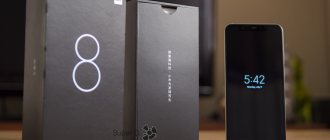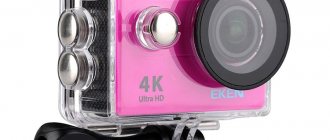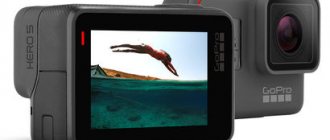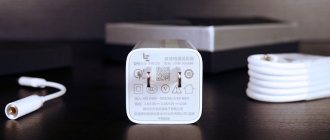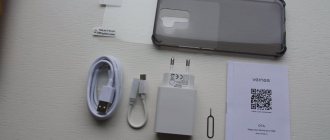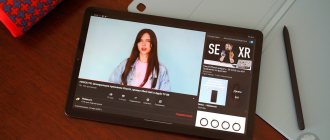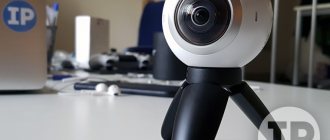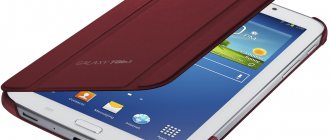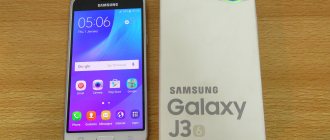The small “mirrorless” Pentax Q was received with hostility by the photo community - due to the tiny size of the sensor. But she wasn't the only one who faced criticism. Three years ago, the release of the Nikon 1 series of “mirrorless” cameras with an inch sensor was actively discussed on photo forums. For a compact, it’s decent, but for a camera with interchangeable lenses, it’s one of the most modest matrices. However, adherents of the Nikon 1 series have always had two weighty arguments for a counterattack: the small size of the body, as well as the possibility of getting a decent telephoto camera with little expense - using an adapter for an “adult” mount and, for example, a universal zoom lens for this mount. In general, Nikon took the first blow of criticism, but this still did not save the Pentax Q. However, now Nikon 1 cameras have caught on, and the Koreans from Samsung decided to test the market - what if “mirrorless cameras” with an inch sensor will bring them unprecedented profits in the camera market?
Samsung NX mini is the thinnest camera with interchangeable lenses. What about “mirrorless” cameras, many ultra-compacts are thicker than our current test subject. In addition, it has a rotating display, and also a touch screen. In addition, there are Wi-Fi and NFC modules with traditionally wide capabilities. Well, to top it all off is a battery of impressive capacity with an impressive declared battery life - 650 frames when tested according to the CIPA standard. This is about twice as much as that of direct and not quite direct competitors, and the largest gap is observed precisely from its main competitor - Nikon 1 S2.
Actually, the camera has many competitors. In addition to Nikon 1 S2, there are also similar-priced Olympus E-PM2 and Panasonic DMC-GF5, which are equipped with a slightly larger Micro Four Thirds sensor (crop factor 2 versus 2.7 for the hero of the material). It is also impossible not to note the Sony DSC-RX100 compact (2nd and 3rd generation), which has the same sensor, and the lens has an impressive zoom ratio and is also quite fast, although the price of the Sony station wagon is higher. We must not forget about indirect, but still competitors in Samsung’s own ranks. The similarly priced models NX1100 and NX2000 are larger, but they have a standard mount - Samsung's NX, and not the smaller NX-M, and the sensor is much larger. In addition, its relatives also have a hot shoe, and the NX2000 also has a touch display. In general, the competition for buyers’ wallets here is serious.
⇡#Technical characteristics declared by the manufacturer
| Samsung NX mini | |
| Image sensor | 13.2 x 8.8 mm CMOS sensor, total resolution: 20.9 MP |
| Effective number of points, MP | 20,5 |
| Image saving format | Still image : RAW, JPEG (DCF Ver. 2.0, Exif Ver. 2.3) Video: MP4 (Video: H.264, Audio: ACC) |
| Lens mount | Samsung NX-M |
| Frame size in pixels | Photo frame : up to 5472×3648 Video : up to 1920×1080 |
| Sensitivity, units in ISO equivalent | Auto, 100, 200, 400, 800, 1600, 3200, 6400, 12800, 25600 (1 or 1/3 EV steps) |
| Shutter speed range, s | Auto: 1/16000 - 30 Manual: 1/8000 - 30 (1/3 EV increments) Manual: up to 4 minutes |
| Exposure metering | 221-zone |
| Exposure metering | Matrix, center-weighted, spot |
| Exposure compensation | From ±3 EV in 1/3 steps |
| Built-in flash | Guide number 4 at ISO 100 |
| Self-timer, s | 2, 10, custom |
| Storage device | microSD, microSDHC, microSDXC, UHS-1 microSD |
| LCD display | LCD matrix with a resolution of 460.8 thousand dots (320x480) and a touch layer |
| Viewfinder | No |
| Interfaces | HDMI, USB 2.0 |
| Nutrition | Li-ion battery, 8.85 Wh |
| Dimensions (WxHxD), mm | 110,4×61,9×22,5 |
| Weight, g | 158 (body only) 196 (with battery and memory card) |
⇡#Supply set
The delivery set includes a 9 mm lens (don’t forget about the crop factor of 2.7, that is, in 35 mm equivalent it is approximately 24 mm) with a maximum aperture of ƒ/3.5, USB cable, USB charger, battery, strap on the hand, which makes the camera even more like a compact, a couple of brochures, a user manual, a disk with an electronic version of the manual and additional software. Separately, it is worth noting the disc with the Lightroom 5 package. And if in the case of the NX30 this software is perceived as a very pleasant bonus, then in the case of the camera under test it seems simply unspeakable generosity, because the cost of the package in the boxed version is a third of the price tag of the NX mini.
Samsung NX1: Conclusions
What I liked:
- Rotatable LCD display with bright and fairly accurate color reproduction
- Feels like you're working with a DSLR camera
- Superior color reproduction and flexible RAW files
What I didn't like:
- Price
So, Samsung has released a camera that is definitely worthy of everyone's attention. Previous models, in our opinion, are inferior to the new product due to excessive dependence on touch screens and not very successful implementation of the photo sharing function. In addition, the very successful design and ergonomics of the NX1 allows you to fully concentrate on the photography process.
The Samsung NX1 feels like a camera, whereas many previous Samsung products felt like a smartphone-camera hybrid. For example, the Galaxy NX uses Android as its operating system, while other models in the NX line put more emphasis on youth-oriented design at the expense of camera ergonomics.
Full-frame purists probably won't find anything interesting the NX1 However, Samsung's new product can quite confidently occupy a niche very close to full-frame cameras: the NX1 can handle some tasks, perhaps, no worse than a full frame.
When faced with choosing a new camera and having the opportunity to spend a sufficient amount of money on it, you can consider the Samsung NX1 as one of the main contenders for purchase. But the cost of the camera is quite high and can scare off many potential buyers. With the 16-50mm f/2.8 kit lens, the Samsung NX1 retails for around $2,800.
Author: Julius Motal
More useful information and news in our Telegram channel “Lessons and secrets of photography”.
Subscribe! Tags: Samsung, Reviews, Cameras
About the author: spp-photo.ru
- Related Posts
- 10 mobile apps to convert photos to black and white
- Comparison of a DSLR camera with a mirrorless one
- Nikon D5. Preview and sample photos
« Previous entry
⇡#Appearance
As already noted, the camera body is extremely thin - its closest competitors lose about 6-10 mm. In fact, the thickness of the “mirrorless” camera is comparable to most ultra-compacts. However, despite the small thickness, the case is quite durable and does not give in at all when trying to twist or squeeze, and also does not make the slightest sound - and this is in the presence of a rotating display. Because of this, it seems that the case is made of metal - but no, it is plastic.
The material of the front panel visually resembles leather, but in fact it is not leather, not leatherette, or even rubber with a leather pattern, but just plastic. Moreover, even on the back side the pad is a plastic imitation of rubber. In general, the manufacturer decided to save money. However, it is worth noting that the weight of the NX mini body and included lens is so light that it is relatively comfortable to hold as is. Although there are no “expensive” materials at all - the cover on the top, thanks to which the design of the camera is greatly enlivened, is cast from an aluminum alloy. There are many color options - white, black, brown, blue and pink.
On the front, in addition to the bayonet mount, there is an autofocus illumination LED, as well as a built-in flash window.
On the back side, most of the surface is occupied by the display. On the right side there are almost all controls: keys for video recording, entering the main menu, calling up the menu for changing the operating mode, switching to viewing mode, deleting, as well as four multifunction buttons, combined into a schematic ring and supplemented by an enter key in the center. In the upper right corner of the rear side there is a system speaker and a mount for the included belt.
At the top there is a shutter button, a power button and a programmable Direct Link button (setting up the wireless data transfer function), a microphone slot, and a connector for connecting an external flash. The flash connector is non-standard - there is simply not enough space for a hot shoe. By the way, a similar approach was also found in Sony “mirrorless” cameras, although recently the Japanese prefer generally accepted standards. At the bottom there is only a connector for mounting on a tripod.
The left side surface is empty. On the right there is a large plug that covers the entire side surface, which hides the connectors for HDMI and USB cables, a slot for installing microSD memory cards, as well as a shaft for installing a flat, but very large battery.
Appearance, housing, usability
If the NX2000 is a child of plastic and a classic representative of the “middle segment,” then the NX300 shines with noble materials and retro design: metal, leather-like coating, an “adult” set of controls ,
a neat and reliable rotating screen mechanism.
On the top edge there are as many as five camera controls.
- Combined with the focus and shutter button, a sliding power switch;
- Actually, the focus/shutter button;
- Wheel for controlling the active camera function;
- Marked shooting mode selection wheel;
- Recessed button for quick activation of wireless functionality.
Regarding the above points, I have no complaints: the first, second and fourth elements are implemented almost perfectly.
The adjustment wheel hidden behind the number 3, in my opinion, rotates too easily - it would have had a slightly more noticeable/tangible “click” on the division and not such a “deep” fit into the camera body - and it would have been simply gorgeous. But point number 5 is still a misunderstanding, but we will return to it a little later.
On the rear panel, in addition to the touchscreen (which can be tilted 90 degrees up and 45 degrees down from its original position), there is a five-way multifunction button that provides navigation through menus and settings, as well as quick access to some functions, buttons for going to the gallery, a button for deleting a photo, a FN button, a button to go to the main camera menu and a button that selects the operating mode of wheel number 3 from the last paragraph - adjusting the shutter speed or aperture. Most of the available buttons can be reassigned/reassigned to other functions through the main menu, thus gaining access to almost any function with one click.
In principle, it’s clear from the icons/labels on the five-way button what each of the “directions” does, so I won’t comment on anything.
Yes, I almost forgot. There is also an inconspicuous button for instantly switching to video recording mode, but it is located in the “dead zone”, which, in principle, is good - you won’t accidentally press it. Interface connectors include USB and HDMI, both with a micro prefix.
What can you say about the available camera controls? There is nothing superfluous here, everything you need is at hand, all buttons are pressed with clear feedback, all switches allow you to work with the camera “blindly”.
Am I ready to call usability ideal? No, I'm not ready. Retro design has made its own adjustments, and I would like to move some elements a little, smooth out some edges, and make the “handle” more anatomical. But if you don’t pay attention to these little things, the camera just fits perfectly in the hand, and, of course, after some getting used to, it can be used as easily as any crop SLR in “manual” mode. ISO is set to an adjustable button, white balance works great in automatic mode, aperture and shutter speed are available both via “wheel 3 + button” and via iFN on the lens... what else is needed for happiness? 
⇡#Display and interface
The NX mini, with its modest thickness, boasts a tilting display, with an opening angle of 180 degrees, which allows you to easily take self-portraits. By the way, regardless of the autofocus mode set, when you rotate the display, the camera automatically switches to portrait mode. Moreover, if the power is turned off, when the display is tilted to the maximum angle, it will automatically turn on. An equally important bonus is the touch layer, which is especially important in the case of a compact camera with many settings and a minimum of controls.
Despite the use of a regular LCD matrix, and not Super AMOLED, as in more expensive solutions, there is no reason to complain about viewing angles, and the display is quite easy to read under sunlight, although a visual assessment of the correct operation of exposure metering in such conditions is impossible. But the screen still has its drawbacks. Firstly, it is low resolution. This is not to say that it is very low, but still individual pixels are noticeable on plain light fields and on graphic menu elements. In addition, there is a lack of contrast: the level of black luminosity is quite high, which is why dark colors are not displayed correctly enough, although otherwise there are no comments on color reproduction. I was pleasantly surprised by the degree of display protection. Even with strong pinpoint pressure in the center of the screen, the protection does not bend at all, and the smooth surface is not particularly resistant to scratches.
The camera interface is almost the same as that of other modern Samsung mirrorless cameras. There are no significant differences here in principle, and the difference lies only in the presence or absence of some menu items. As already noted, the little NX mini has few classic controls, so support for touch input greatly simplifies the operation of the menu. It is worth noting that the hybrid control in the latest Samsung cameras has been worked out quite well, and in terms of convenience it can be put on par with the hybrid control of Panasonic “touch” cameras. Using the touch screen, you can control not only the quick menu, but also the main one. In fact, without classic keys you can change almost everything. Exclusively using regular keys, you can only call up the shooting mode selection menu, change the display display mode, start and end video recording, and switch to playback mode. The response to pressing keys, both real and virtual, is quite fast, and no menu slowdowns were noticed while working with the camera. Below are some screenshots to familiarize yourself with the menu.
Samsung NX1: Autofocus
The autofocus system, based on 205 phase and 209 contrast sensors, works quickly and efficiently in most situations. During my time with the camera, there were no situations where the autofocus missed, which suggests that the Samsung NX1 is smart enough to correctly select the subject to focus on based on the composition.
After switching focus mode from auto to manual, the NX1 continues to focus successfully, aided by a high-contrast feature that highlights the edges of the in-focus subject. It's safe to say that photojournalists, sports and wedding photographers can confidently rely on the NX1's .
⇡#Camera Features
The manufacturer especially emphasizes the small thickness and overall compactness of the device. The camera is really small - with the included “fix” you can easily put it in the breast pocket of a shirt. Yes, it will stick out and pull back, but this is possible, whereas even with the Pentax Q series mirrorless cameras equipped with tiny 1/2.3-1/1.7-inch sensors, this will not work. But the hero of the material has an inch sensor.
A much more important feature is the presence of Wi-Fi and NFC modules. It’s not that it’s impossible to live without them in the modern world, but it’s much more convenient, and the functionality expands greatly. It is worth noting here that it is precisely in terms of functionality that Samsung’s bundle of wireless camera modules is far ahead of all its rivals, and only solutions from Panasonic and Sony can provide worthy competition here. Moreover, this statement applies not only to the most expensive solutions, but also to relatively inexpensive “wireless” compacts, and, of course, Samsung NX mini. However, there are still some differences from the older models of the NX series. For example, the camera we tested only works in the 2.4 GHz band, while, for example, the NX30 is capable of working in the 5 GHz band, which is not so busy right now.
One of the most popular functions is shooting control using a smartphone on Android or iOS. Of course, data transfer to a smartphone is also possible. But much more interesting is the ability to send pictures to social networks and various cloud services - Odnoklassniki, VKontakte, Facebook, Picasa, Flickr, YouTube and Dropbox, as well as to Samsung Link cloud storage - and all this without the help of a PC or smartphone. Again, without their help, it is possible to send photos by mail. It should also be noted that it is possible to transfer footage to DLNA devices. There is also the already familiar function of automatic copying to a PC, which allows you to quickly download the footage to your computer without thinking about it. It is worth noting that in any of the listed data transfer modes, photos can be sent either in the original resolution or with automatic resizing on the fly up to 2 MP. Another important function is Baby Monitor, which is essentially a video nanny broadcast to a smartphone. The program allows you not only to monitor, but also to respond to increased noise levels, although this function is only useful when used in a quiet room. If your windows overlook a noisy avenue, then there will be a lot of false alarms. The camera is equipped with a very capacious battery, but when using the Baby Monitor for a long time, it is still better to use the included USB charger for power. However, not everything is smooth here - the included USB cable is too short.
Of course, equipped with a rotating display with an opening angle of 180 degrees, the camera could not do without a mode for detecting faces and smiles. Smiles are detected just perfectly. But there is one problem - the delay between directly detecting a smile and shooting is quite long due to the relatively slow autofocus, so the camera is not able to catch a fleeting smile. It’s worth noting in advance that, in general, autofocus is quite fast, and only on faces does it struggle for inexplicable reasons. Also in the settings there is a function for shooting without blinking, but, unfortunately, it is completely inoperative and does not affect the shooting process in any way.
Premium system camera Samsung NX30 Kit 18-55 Black - Specifications
Introducing the latest SMART camera Samsung NX30 with hybrid autofocus, 20 megapixels. sensor, dual displays and ultra-fast (1/8,000 sec) shutter, guaranteeing the highest quality images and maximum shooting convenience. The characteristics of the universal camera Samsung SMART camera NX30 will satisfy the most demanding photographers. The 20.3-megapixel APS-C CMOS sensor ensures excellent photo quality even in low light, the hybrid autofocus system ensures high image clarity, and the ultra-fast shutter with a minimum shutter speed of 1/8,000 second allows you to capture clear shots of dynamic scenes with fast-moving objects. Built-in NFC (Near Field Communication) and Wi-Fi support let you quickly send photos to your smartphone or tablet with just one touch of the camera screen. Finally, the dynamic design, tiltable electronic viewfinder, combined with an ultra-bright, rotating Super AMOLED touchscreen display make this camera a true professional camera.
Improved 20.3 MP APS-C CMOS sensor
The NX30 mirrorless camera's built-in Hybrid AF (Auto Focus) system and large 20.3-megapixel sensor deliver near-instantaneous focus, delivering images with the quality of traditional DSLR cameras with stunning background blur when shooting at large apertures. diaphragm. The hybrid autofocus system uses phase-detection and contrast-detection AF for faster, more accurate image focusing in auto mode. The 23.5 x 15.7mm sensor captures maximum light and delivers the highest quality photos and videos. With minimal shutter lag after the shutter is pressed, the Hybrid AF system ensures exceptionally clear photos are captured instantly.
Ultra-fast shutter speed 1/8,000 second
With an ultra-fast shutter speed of 1/8,000 second, the Samsung SMART CAMERA NX30 allows you to capture the most dynamic scenes in great detail. Ultra-fast shutter speeds and a fast autofocus system allow you to capture images of fast-moving subjects without the slightest blur.
You can share the photo immediately after taking it
Support for Wi-Fi and NFC functions opens up a huge world of new possibilities for you. Photo Beam lets you send your photo or video to a friend on your smartphone when you touch the back of the camera to the back of your smartphone, while Mobile Link lets you share content remotely. Another feature of the Tag & Go mode is the Remote Viewfinder option, which allows you to control the camera directly from your smartphone. AutoShare automatically sends your photos to your smartphone or tablet via Wi-Fi and NFC technology. Not only does your camera come with Dropbox built-in, you also get 50GB of cloud storage for 2 years. Sharing and saving photos has never been easier.
Share photos with one touch
You can send a photo to your friend with one touch directly from your camera. Photo Beam lets you send photos to anyone with just one tap on the camera screen. To do this, activate the SMART CAMERA mode on any NFC-compatible smartphone so that this image is automatically displayed on another smartphone. It is so simple!
Consider all the details
The tilting electronic viewfinder with a resolution of 2,359 thousand dots and a 100% field of view is very convenient when choosing the composition of the shot, as it provides excellent visibility of the entire scene. The use of OLED technology in the 75 mm (3-) Full VGA Super AMOLED screen guarantees a bright and clear color image with the highest contrast and no blur effect when moving the camera. A rotating screen with a rotation angle of 270° in the vertical plane and 180° in the horizontal plane is an excellent opportunity to take exceptionally spectacular pictures from an unusual angle. The high brightness of the Super AMOLED screen ensures excellent image visibility even in bright sunlight.
Relive the best moments
Shoot Full HD 1080 / 50p video in great detail without blurring the image when the camera moves. Smart Range+ automatically ensures the correct color tone and detail in shadows and highlights. The 3.5mm microphone jack allows you to use a 3.5pi microphone to record stereo sound for your video. Stop! Removed? Use the HDMI connector to display video on your HDTV.
Powerful processor for great photos
The brand's new DRIMe IV digital image processor makes it easy to capture and instantly edit photos of your special moments. This processor is significantly more powerful than its predecessor, has higher performance, excellent color reproduction and low noise level. Whether you shoot in 2D or 3D, Full HD resolution lets you enjoy viewing your photos and videos on your Full HD TV.
Capture fast-moving scenes with burst mode
If you're filming a jump over an obstacle, you only have a split second to get a good shot. Continuous shooting mode will allow you to take a whole series of pictures at a speed of 9 frames per second.
Large ISO range for low light shooting
In order to take good and correctly exposed pictures with natural color rendition indoors or outdoors in the evening or at night, the camera must have a large range of changes in ISO sensitivity. The Samsung SMART CAMERA NX30 can take pictures at ISO 25600, which is twice the maximum light sensitivity of its predecessor. Thanks to this, you can take clear pictures even in low light with low noise.
i-Function 2.0 system
Use i-Function Control to quickly select aperture, shutter speed, exposure compensation and ISO with one button and the turn of the lens barrel ring. Finally, you can program buttons on the camera for quick access to frequently used settings, and more experienced users can assign hot buttons to access additional settings.
⇡#Shooting and impressions of work
The speed of preparation for work for most “mirrorless” cameras is relatively high, although there are exceptions. But even the slowest models turn out to be faster than the vast majority of compacts. The range of 0.3-0.6 seconds can be considered a guideline. The NX mini is equipped with a fixed focal length lens, which saves some time compared to zoom lenses. However, the complete lens still needs to be in working position, as in the case of compacts, because in the transport position it is very tiny and protrudes above the body by only 12 mm. However, only 0.71 seconds elapse between pressing the power key and starting the focusing process. Not bad - considering the features of the lens. It is noteworthy that the structurally completely different Samsung NX30, which was recently tested, completed the same 0.7 seconds.
The speed and duration of a series were measured in three modes: in JPEG format with the least compression, in RAW format, and RAW+JPEG with the least compression. All formats were set to the maximum available resolution. Focus was set to manual mode, shutter speed was 1/1000 second, and various software processing was disabled. The camera is capable of shooting bursts at a stated speed of 6 frames per second, which is quite good for such a little thing, but among its competitors only the Panasonic Lumix GF5 is slower, the stock of which will soon disappear from the shelves. However, what is much more important is not the speed, but the duration of the series. And if previously everything depended on the size of the buffer, now, at least when shooting in JPEG, the data transfer path from the buffer to the memory card often becomes the “bottleneck”. Unfortunately, there was no very fast microSD memory card in the test park, so testing was carried out with a regular Transcend class 10 card. And with it the results look disappointing. In the RAW and RAW+JPEG formats, delays began after four frames were captured, and when using the JPEG format at the maximum burst speed, it was possible to get a maximum of a dozen pictures. In general, quite modest. Of course, an increase in duration is possible when using faster memory cards, but still you can’t count on a series of 100 frames - the buffer is tiny, like the camera itself. In addition, even if the controls are not blocked while recording a series to the memory card, the interface at this time is terribly slow, and reactions to pressing occur with a long delay, so much so that the desire to use the menu at the time of recording data completely disappears.
The focusing speed was measured in good lighting (1000 lux at the control point in the center of the template), a test still life used to assess the noise level was used as a pointing object, focusing was done in the central zone, before each measurement the camera was pointed at infinity, shooting was done from a distance 50 cm. Ultra-compact lenses, even if they are “pancakes”, rarely show good results, but our test subject, in conjunction with the Samsung NX-M 9mm F3.5 ED lens, was able to pleasantly surprise - 0.23 seconds. Of course, there are “mirrorless” cameras that do it in a tenth of a second, but even this result is very good. We’ve already talked about the unexpected slowness of autofocus on faces...
There are only three modes for selecting focus zones, as in the case of the older NX series camera: multi-segment, single zone and face detection. As already mentioned, the face detection mode works quite well, and when you rotate the display 180°, autofocus automatically switches to it. Thanks to the presence of a touch layer, manual selection of the focus area is reduced to the need to point your finger at the desired object. Moreover, it is possible to simply select a zone or touch the shutter release. Focusing can operate in single, continuous and manual modes. And this is where the difficulties begin. The fact is that lenses for the NX-M mount do not have a pseudo-mechanical focusing drive ring, at least not in the already presented trio of “glasses,” so for manual focusing you have to use the camera controls directly. You can navigate using the scale on the screen, but it is impossible to drag it using touch controls, and adjustments are only available using the left and right keys (66 positions). Among the assistants, only an increase in the focusing zone is provided by 5 or 8 times, and only the central zone is increased, which is not always convenient. However, it is extremely rare to resort to manual focusing, because usually automation copes well with its tasks even in difficult conditions. And even in extremely low light conditions, the NX mini does not give up. For example, the automation was able to target the test pattern with illumination of only 0.5 lux. Of course, on a moonlit night without light sources in the frame, such a trick will not work, but in less difficult conditions the automation will cope.
Like any other “mirrorless” camera, the NX mini has all the standard exposure pair setting modes - PASM. However, the camera under test does not have control dials at all, so shutter speed and aperture are controlled using the touch screen or keys. The first method is clearly more convenient. Control is possible not only through the quick menu, but also through a special menu for controlling the exposure couple, called up by clicking on the values displayed on the screen. Exposure metering for 221 zones also works in quite standard modes - matrix, center-weighted and spot. Exposure correction is possible within -3...+3 EV in steps of a third of a stop. There is also shooting with bracketing, but only for three frames, although the bracket is quite standard - from 0.3 to 3 steps. Various dynamic range enhancement functions are also provided. When using a purely software method, the minimum sensitivity level is limited to 200 ISO equivalent. However, there is not much use from this function. But in HDR mode the effect is much more noticeable. But there are some drawbacks here. To begin with, only three frames are stitched together, and there are no settings for the activity of the function (for example, exposure step) at all. In addition, merging an HDR image is disastrously slow - it takes 22 endless seconds. Only some Pentax DSLRs had previously shown similarly disastrous results. And it cannot be said that the processor power is not enough - most likely, a firmware flaw is to blame, but when it will be fixed is unclear, because the camera, or rather its commercial version, has been available for many days, and obvious flaws should have been corrected by now. As for the accuracy of exposure metering, the NX mini is pleasantly pleased. In natural light, the automation often works perfectly regardless of weather conditions, and only a large difference in the brightness of different zones in the frame can cause it to make a serious mistake, for example, a heavily shaded object or the sun entering the frame. The automation also works quite well under artificial lighting. In laboratory conditions, when using incandescent lamps, the error reaches 0.26 EV, which is a completely acceptable result, especially for lamps of this type. When using fluorescent lamps, the error is completely miniscule - up to -0.06 EV.
The white balance settings provide seven presets (sunny, cloudy, incandescent, flash and three essentially useless preset options for fluorescent lamps), as well as an automatic mode and a manual mode for setting color temperature from 2,500 to 10,000 K in 100 K steps There is also a simple manual mode, but with only one container for storing settings, which is not always enough. Each preset has its own fine-tuning on the AB/GM scale (±7 positions). It also allows shooting with white balance bracketing by 1, 2 or 3 steps on the AB or GM scale. In natural light, the automation works quite well, regardless of weather conditions. But with artificial lighting, mistakes do happen. And not only when using incandescent lamps, which are difficult for the vast majority of cameras, but also fluorescent lamps, which, on the contrary, are usually not an insurmountable problem. However, when using fluorescent lamps the deviations are small, but for incandescent lamps it is worth using the appropriate preset.
To assess the correctness of automatic determination of white balance, the Colorchecker 24 table was used. The selected constant light sources were fluorescent lamps with a color temperature of 5500 K, as well as incandescent lamp illuminators. The test results are shown below.
Automatic BB, fluorescent lighting 5500 K
Automatic BB, incandescent lighting
In the images in each field, the small inner rectangle is the reference color, and the inner square is the one obtained by the camera, but adjusted for brightness and contrast, the outer square is the raw area obtained from the camera. Red numbers indicate color deviations on the S scale in the HSV color space, and blue numbers indicate color deviations in degrees Kelvin [Meredah].
Samsung NX mini camera review
Samsung has released another camera for socially active citizens with very impressive characteristics: 20 megapixels, 6 fps, ISO 160-12800, shutter speed up to 1/6000s, interchangeable lenses - and all this in a miniature body, closer in size to a smartphone, rather than to the camera.
In reality, everything turned out to be not as optimistic as on the manufacturer’s website. However, it is worth noting that autofocus is relatively fast by the standards of mirrorless cameras. Featuring a touchscreen, the camera also allows you to point at an area in the image to focus, which is great when there's a lot on the screen. This is definitely better than the focus area selection found on larger cameras. On the other hand, the screen is the only viewfinder; there is no eyepiece in the NX mini. So, in bright sunshine, you have to guess what is in the frame and what is not. The display can also tilt vertically 180 degrees for self-portraits, while the camera turns on and goes into “portrait retouching” mode, which automatically improves the skin, as in numerous filters for Photoshop. Compared to other cameras, the Samsung NX mini does this very well.
The kit includes either a 9mm prime or a 9-27mm zoom (analogous to 18-55mm on 35mm cameras). Considering the size of the sensor, which is small - 7 times smaller than the FX sensor on Nikon, one of the problems is noise at high ISOs. A high ISO here can be considered any value above 160. It is curious that at ISO 160 the noise reduction is not yet noticeable, but at ISO 200 it is already rampant, so much so that 20 megapixels are down the drain, every single one of them. Unfortunately, the noise reduction does not turn off and significantly reduces the detail of the picture. Almost all your photos will be affected by this effect, since according to statistics, most photos are taken in low light. The noise reduction work is clearly visible at 100% crop, this is an example at ISO 1600:
Honestly, with good optics, even on a 12-megapixel camera, the detail will be higher. But the noise was overcome.
The standard zoom lens looks stylish, but is inconvenient to use. Firstly, to start working, you need to put it into working condition by turning it from the locking position to the 9mm mark or further. Secondly, the surface of the lens is absolutely smooth and there is nothing for your fingers to catch on, so turning it is inconvenient. In addition, it is not always possible to understand by touch whether you have turned the lens or not. Needless to say, with such a system you will not be able to take the camera out of your bag with one hand and quickly take a picture. Almost any operation requires manipulation with both hands, so in an emergency you will not be able to quickly take a photo. In this regard, I recommend taking lenses in which you don’t need to turn anything.
There is one more note regarding ergonomics - the power button is indistinguishable from the Wi-Fi button to the touch, you always have to watch where you are pressing. Sometimes I even manage to press the camera shutter button instead of the shutter button; although the shutter release is larger, the button itself is just as inexpressive and hard to see.
Wi-Fi is a different story. The idea itself is very good, and I have been waiting for this on cameras for a long time. But specifically on the Samsung NX mini this is done in such a way that it is completely impossible to use. To upload a photo via Wi-Fi somewhere, you first need to complete the quest from the menu and settings. Initially, integration with social networks was supposed, but my attempts ended after an unsuccessful connection to Dropbox. I was never able to download photos from the camera, and the application interface itself looked like a WAP page from 2002:
Although the Samsung NX mini does not have a standard flash shoe, it does have a built-in flash, which is only suitable as a fill flash when you are shooting against the light. Unfortunately, I was unable to use the built-in flash as a signal for the large Yongnuo YN-560III. Yongnuo only worked when the built-in Samsung flash was in second-curtain sync mode, and for some reason not always. That is, sometimes it worked, but most often it didn’t.
And I don’t recommend shooting against the sun with a standard lens, since it really likes to catch hares, sometimes it comes to real psychedelia:
You can even get a rainbow bunny like the one at the bottom of the frame:
But if you are not involved in photographic extremism, like me, then in principle you can get good shots with real rainbows, and not parasitic ones:
This will be enough for an inexperienced client, but for my taste the color rendition in the NX mini is not very good. In standard settings, the picture is too faded and lacks contrast for my taste. And if you turn on bright colors, the photo begins to give off an acidic feel. This is easy to see if you compare it with the colors produced by the Nikon D7100, with which I photographed approximately the same things under the same conditions.
In addition to photos, the NX mini can shoot FullHD video, but keep in mind that autofocus will wander around as helplessly as on DSLRs, and in manual focus mode you will have nothing to turn on the lens - the focus is adjusted using the buttons on the back of the camera very slowly and with large jerks. Therefore, I would immediately forget about the video.
Another myth about the rate of fire. 6 frames per second is a really serious request. But keep in mind that like any other mirrorless camera, the NX mini will not be able to adjust the focus between frames, so you won’t be able to shoot anything fast-moving and in focus in this mode. The question arises why such a rate of fire is needed at all, even if you don’t really photograph the child. Any, even the simplest SLR camera will cope with this task much better, without having such impressive characteristics.
It is worth noting that the Samsung NX mini supports microSD memory cards and is charged via micro USB, which is a big plus, saving you from the need to carry additional chargers with you. The built-in battery lasts all day, unlike the Samsung Galaxy Camera.
It is surprising that Samsung itself has much better color rendition of the Galaxy S4 smartphone camera than the NX mini camera. They say the camera on the Galaxy S5 is even better, but I haven't had a chance to test it yet.
Photos taken with Samsung NX mini can be viewed in the gallery:
https://lospopadosos.com/russia/moscow/samsungnx
⇡#Photographic tests
Noises
To assess noise, the following method was used: a group of multi-colored objects was photographed with all sensitivity values in JPEG format with minimal compression, as well as in RAW format, followed by conversion by the bundled software into TIFF format with standard settings. White balance was set automatically. The test target was also photographed with the noise reduction mode activated. Crop fragments were created in Photoshop CC and then saved in JPEG format with a minimum compression ratio. In the image below, green squares indicate the areas of cropped fragments. Test footage was shot at sensitivities ranging from 100 to 25,600 ISO equivalent.
| Fr 1 | RAW | JPEG Without Silk | JPEG Low Silk | JPEG Standard Silk | JPEG Strong Silk |
| ISO 100 | |||||
| ISO 200 | |||||
| ISO 400 | |||||
| ISO 800 | |||||
| ISO 1600 | |||||
| ISO 3200 | |||||
| ISO 6400 | |||||
| ISO 12800 | |||||
| ISO 25600 |
| Fr 2 | RAW | JPEG Without Silk | JPEG Low Silk | JPEG Standard Silk | JPEG Strong Silk |
| ISO 100 | |||||
| ISO 200 | |||||
| ISO 400 | |||||
| ISO 800 | |||||
| ISO 1600 | |||||
| ISO 3200 | |||||
| ISO 6400 | |||||
| ISO 12800 | |||||
| ISO 25600 |
| Fr 3 | RAW | JPEG Without Silk | JPEG Low Silk | JPEG Standard Silk | JPEG Strong Silk |
| ISO 100 | |||||
| ISO 200 | |||||
| ISO 400 | |||||
| ISO 800 | |||||
| ISO 1600 | |||||
| ISO 3200 | |||||
| ISO 6400 | |||||
| ISO 12800 | |||||
| ISO 25600 |
Shooting in RAW format (converted to TIFF)
Follow the link for a full-length file with complete metadata. EGF=24 mm, ƒ/11, 1/4, ISO 100
Follow the link for a full-length file with complete metadata. EGF=24 mm, ƒ/11, 1/8 s, ISO 200
Follow the link for a full-length file with complete metadata. EGF=24 mm, ƒ/11, 1/15 s, ISO 400
Follow the link for a full-length file with complete metadata. EGF=24 mm, ƒ/11, 1/30 s, ISO 800
Follow the link for a full-length file with full metadata. EGF=24 mm, ƒ/11, 1/60 s, ISO 1600
Follow the link for a full-length file with complete metadata. EGF=24 mm, ƒ/11, 1/125 s, ISO 3200
Follow the link for a full-length file with complete metadata. EGF=24 mm, ƒ/11, 1/250 s, ISO 6400
Follow the link for a full-length file with complete metadata. EGF=24 mm, ƒ/11, 1/500 s, ISO 12800
Follow the link for a full-length file with complete metadata. EGF=24 mm, ƒ/11, 1/1000, ISO 25 600
JPEG, noise reduction disabled
By
- full-length file with complete metadata. EGF=24 mm, ƒ/11, 1/4, ISO 100
By
- full-length file with complete metadata. EGF=24 mm, ƒ/11, 1/8 s, ISO 200
By
- full-length file with complete metadata. EGF=24 mm, ƒ/11, 1/15 s, ISO 400
By
- full-length file with complete metadata. EGF=24 mm, ƒ/11, 1/30 s, ISO 800
By
- full-length file with complete metadata. EGF=24 mm, ƒ/11, 1/60 s, ISO 1600
By
- full-length file with complete metadata. EGF=24 mm, ƒ/11, 1/125 s, ISO 3200
By
- full-length file with complete metadata. EGF=24 mm, ƒ/11, 1/250 s, ISO 6400
By
- full-length file with complete metadata. EGF=24 mm, ƒ/11, 1/500 s, ISO 12800
By
- full-length file with complete metadata. EGF=24 mm, ƒ/11, 1/1000, ISO 25 600
JPEG, low noise reduction
By
- full-length file with complete metadata. EGF=24 mm, ƒ/11, 1/4, ISO 100
By
- full-length file with complete metadata. EGF=24 mm, ƒ/11, 1/8 s, ISO 200
By
- full-length file with complete metadata. EGF=24 mm, ƒ/11, 1/15 s, ISO 400
By
- full-length file with complete metadata. EGF=24 mm, ƒ/11, 1/30 s, ISO 800
By
- full-length file with complete metadata. EGF=24 mm, ƒ/11, 1/60 s, ISO 1600
By
- full-length file with complete metadata. EGF=24 mm, ƒ/11, 1/125 s, ISO 3200
By
- full-length file with complete metadata. EGF=24 mm, ƒ/11, 1/250 s, ISO 6400
By
- full-length file with complete metadata. EGF=24 mm, ƒ/11, 1/500 s, ISO 12800
By
- full-length file with complete metadata. EGF=24 mm, ƒ/11, 1/1000, ISO 25 600
JPEG, standard noise reduction
By
- full-length file with complete metadata. EGF=24 mm, ƒ/11, 1/4, ISO 100
By
- full-length file with complete metadata. EGF=24 mm, ƒ/11, 1/8 s, ISO 200
By
- full-length file with complete metadata. EGF=24 mm, ƒ/11, 1/15 s, ISO 400
By
- full-length file with complete metadata. EGF=24 mm, ƒ/11, 1/30 s, ISO 800
By
- full-length file with complete metadata. EGF=24 mm, ƒ/11, 1/60 s, ISO 1600
By
- full-length file with complete metadata. EGF=24 mm, ƒ/11, 1/125 s, ISO 3200
By
- full-length file with complete metadata. EGF=24 mm, ƒ/11, 1/250 s, ISO 6400
By
- full-length file with complete metadata. EGF=24 mm, ƒ/11, 1/500 s, ISO 12800
By
- full-length file with complete metadata. EGF=24 mm, ƒ/11, 1/1000, ISO 25 600
JPEG, strong noise reduction
By
- full-length file with complete metadata. EGF=24 mm, ƒ/11, 1/4, ISO 100
By
- full-length file with complete metadata. EGF=24 mm, ƒ/11, 1/8 s, ISO 200
By
- full-length file with complete metadata. EGF=24 mm, ƒ/11, 1/15 s, ISO 400
By
- full-length file with complete metadata. EGF=24 mm, ƒ/11, 1/30 s, ISO 800
By
- full-length file with complete metadata. EGF=24 mm, ƒ/11, 1/60 s, ISO 1600
By
- full-length file with complete metadata. EGF=24 mm, ƒ/11, 1/125 s, ISO 3200
By
- full-length file with complete metadata. EGF=24 mm, ƒ/11, 1/250 s, ISO 6400
By
- full-length file with complete metadata. EGF=24 mm, ƒ/11, 1/500 s, ISO 12800
By
- full-length file with complete metadata. EGF=24 mm, ƒ/11, 1/1000, ISO 25 600
⇡#Flash
The tiny NX mini is equipped with a built-in flash with a modest guide number of 4.5 at ISO 100. But do not forget that the Nikon J4 and S2 have a guide number not much higher - 5 at ISO 100. However, both Nikon cameras do not have the ability to connect external flashes, but the hero of the material has such an opportunity. The only problem is that there is a special connector for an external flash - the dimensions of the case do not allow the installation of a standard “hot shoe”. However, it is worth noting here that the smallest “mirrorless” Olympus camera has a “hot shoe”. Yes, and similar in cost, but their larger relatives NX2000 and NX1100 are not deprived of it.
As for the built-in flash itself, it operates in the following modes: fill, red-eye reduction, and first or second curtain sync. There is also a correction mode in the range of -2...+2 EV, but the correction step is not the usual 1/3 EV, but half a step. The flash recycles extremely quickly. Our test technique involves shooting in rapid succession with flash for a minute. Fortunately, the camera supports continuous shooting with flash, so the experiment in the case of the NX mini is completely clean. As a result, in a minute the camera captured 142 frames with flash - almost 2.4 frames per second. Of course, we shouldn’t forget that the flash power is low, but for such a tiny thing the result is still impressive. In addition, at exactly the same speed, the NX mini can shoot with flash until the battery drains. Below, for your reference, is an example of shooting a test pattern in program mode without correction.
Shooting in a dark room with flash. Flash compensation: 0
Samsung NX1: Specifications
- 28.2 megapixel BSI APS-C CMOS sensor
- DRIMe V GPU
- Supports 4K video recording at 24 fps
- Supports UHD video recording at 30fps
- 3.0″ touch rotating LCD display
- XGA OLED electronic viewfinder
- Advanced Hybrid AF System
- 205 phase detection autofocus points
- Rate of fire: 15 frames per second with autofocus support
In addition, a firmware update is expected in the near future, which will be able to further meet the needs of videographers.
⇡#Sample pictures
Sample pictures
View all images (21)
Here you can.
⇡#Working in video shooting mode
Despite the growing popularity, as well as the widespread use of the 1080/50p recording format, the hero of the material when recording Full HD video is limited to the 25p mode. Moreover, there are no 50 frames even when recording video with a resolution of 1280x720 pixels. The settings provide control of white balance, exposure compensation and exposure pair parameters, and in all standard modes (PASM). In addition, it is possible to control the sensitivity level, but in video mode the maximum value is 3200 units in ISO-equivalence: even if you select a higher sensitivity level, after pressing the movie record key, it automatically switches to the specified value. In video recording mode, autofocus can operate in both single-frame and continuous modes, and in the latter case, the adjustment is done quite gently, so this process is not particularly noticeable during subsequent viewing. The NX mini only has one microphone, which is like saving money on matches. In addition, it does not allow you to adjust the volume or set up software wind noise reduction. Below is an example of a video recording in the highest possible quality for your reference.
1080/25p recording example
⇡#Power supplies and battery life
The NX mini uses a B740AE lithium-ion battery. This battery has never been found in Samsung cameras before—it can only be found in the company’s smartphones. Most likely, it was the dimensions of the battery that became decisive when choosing it, because it is thin and wide - what is needed for the thinnest “mirrorless” camera. The battery capacity is not impressive, but still impressive - 8.85 Wh. The declared battery life is even more impressive - 650 frames when tested according to the CIPA standard. This is 2.4 times more than stated for Nikon 1 S2, and indeed none of the competitors even comes close to this figure. Unfortunately, there is no protection against incorrect installation of the battery - you need to pay attention to the position of the contact group. However, in the case of a camera it is more difficult to do this than in the case of a smartphone, because the contacts are located deep in the narrow connector, so in low light they are almost invisible.
In everyday shooting conditions, the battery allowed us to shoot 785 frames. Unfortunately, the charge level indicator is only a 3-segment, which is clearly not enough for control. Recharge is carried out using USB charging or from any USB port.
